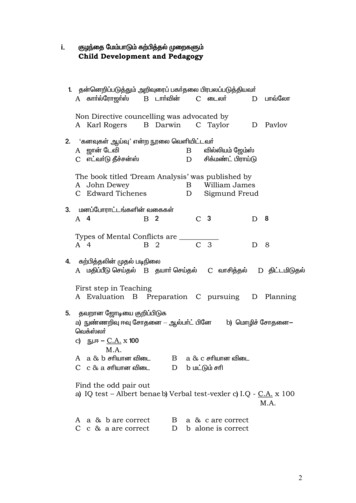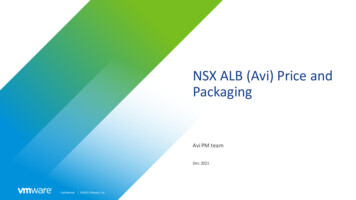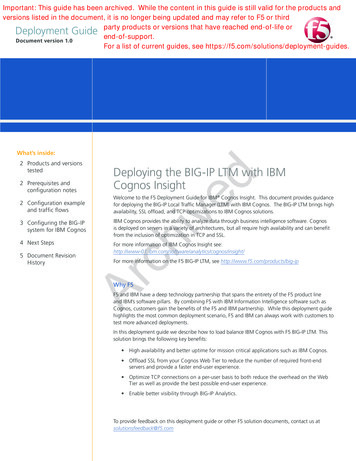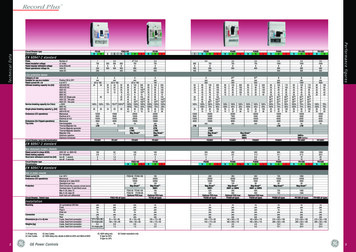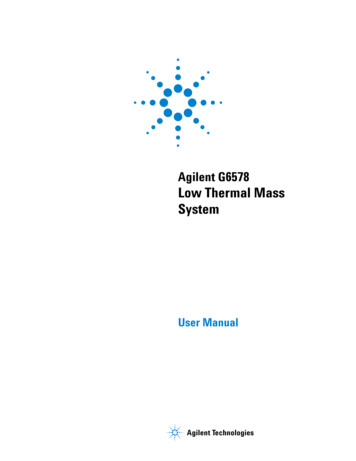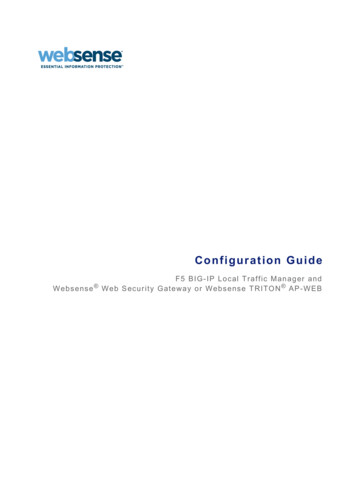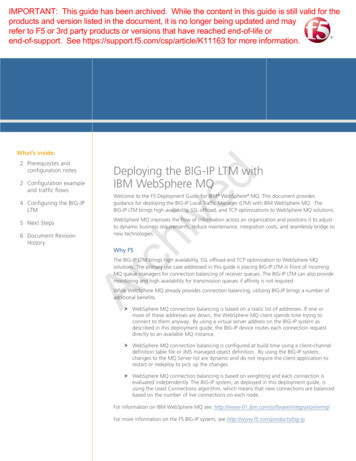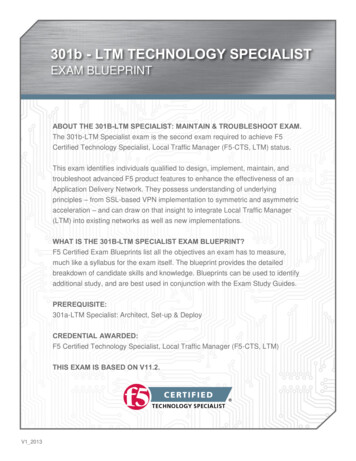
Transcription
301b - LTM TECHNOLOGY SPECIALISTEXAM BLUEPRINTABOUT THE 301B-LTM SPECIALIST: MAINTAIN & TROUBLESHOOT EXAM.The 301b-LTM Specialist exam is the second exam required to achieve F5Certified Technology Specialist, Local Traffic Manager (F5-CTS, LTM) status.This exam identifies individuals qualified to design, implement, maintain, andtroubleshoot advanced F5 product features to enhance the effectiveness of anApplication Delivery Network. They possess understanding of underlyingprinciples – from SSL-based VPN implementation to symmetric and asymmetricacceleration – and can draw on that insight to integrate Local Traffic Manager(LTM) into existing networks as well as new implementations.WHAT IS THE 301B-LTM SPECIALIST EXAM BLUEPRINT?F5 Certified Exam Blueprints list all the objectives an exam has to measure,much like a syllabus for the exam itself. The blueprint provides the detailedbreakdown of candidate skills and knowledge. Blueprints can be used to identifyadditional study, and are best used in conjunction with the Exam Study Guides.PREREQUISITE:301a-LTM Specialist: Architect, Set-up & DeployCREDENTIAL AWARDED:F5 Certified Technology Specialist, Local Traffic Manager (F5-CTS, LTM)THIS EXAM IS BASED ON V11.2.V1 2013
301b - LTM TECHNOLOGY SPECIALISTEXAM BLUEPRINT201 - TMOS TECHNOLOGY SPECIALISTSectionEXAM1:MaintainApplication and LTM Device HealthBLUEPRINTCognitiveComplexityObjective 1.01Given a scenario, determine the appropriate profile setting modifications.ExamplesDetermine the effect of changing profile settings on application trafficDetermine if changing profile settings will affect the LTM device or the applicationExplain the effect of modifying buffer settings in the TCP profileExplain the effect of modifying time out settings in the TCP/UDP profileDetermine the effect of TCP/UDP profile interaction with other profiles (e.g. OneConnect, HTTP, FTP, etc.For example, how modifying settings in TCP profile can break FTP)Describe how the source of traffic affects TCP/UDP profile settings that should be selectedDetermine the appropriate settings to use based on a given application behaviorDetermine the appropriate netmask settings when using a OneConnect profileObjective 1.02ExamplesObjective 1.03ExamplesObjective 1.04ExamplesObjective 1.05Given a sub-set of an LTM configuration, determine which objects to removeor consolidate to simplify the LTM configurationU/AU/AInterpret configurationIdentify redundant application functionsDescribe how to consolidate redundant application functionsDetermine the appropriate redundant function to remove/keepExplain the effect of removing functions from the LTM device configurationGiven a set of LTM device statistics, determine which objects to remove orconsolidate to simplify the LTM configurationU/AInterpret performance statisticsIdentify redundant application functionsDescribe how to consolidate redundant application functionsDetermine the appropriate redundant function to remove/keepExplain the effect of removing functions from the LTM device configurationGiven a scenario, determine the appropriate upgrade and recovery stepsrequired to restore functionality to LTM devicesRExplain how to upgrade a vCMP environmentExplain how to upgrade an LTM device from the GUIDescribe the effect of performing an upgrade in an environment with device groups and traffic groupsExplain how to perform an upgrade in a high availability groupDescribe the process for using SCF and UCS filesGiven a scenario, determine the appropriate upgrade steps required tominimize application outagesCognitive Complexity Key:R RememberA/E Analyze/EvaluateU/A Understand/ApplyU/A301b - LTM Technology Specialist exam blueprintBased on v11.2 2
301b - LTM TECHNOLOGY SPECIALISTEXAM BLUEPRINTExamplesExplain how to upgrade a vCMP environmentExplain how to upgrade an LTM device from the GUIDescribe the effect of performing an upgrade in an environment with device groups and traffic groupsExplain how to perform an upgrade in a high availability groupDescribe the process for using SCF and UCS filesObjective 1.06Describe the benefits of custom alerting within an LTM environmentExamplesDescribe Enterprise Manager, its uses, and alerting capabilitiesDescribe AVR alerting capabilitiesObjective 1.07Describe how to set up custom alerting for an LTM deviceExamplesList and describe custom alerts: SNMP, email and Remote SyslogIdentify the location of custom alert configuration filesIdentify the available levels for local traffic loggingIdentify the steps to trigger custom alerts for testing purposesSection 2:Troubleshoot basic hardware issuesObjective 2.01Determine which iRule to use to resolve an application issueExamplesDetermine which iRule events and commands to useObjective 2.02Explain the functionality of a given iRuleExamplesInterpret information in iRule logs to determine the iRule and iRule events where they occurredDescribe the results of iRule errorsObjective 2.03Interpret AVR information to identify performance issues or application attacksExamplesExplain how to use AVR to trace application trafficExplain how latency trends identify application tier bottlenecksExplain browser requirements to obtain page load time dataExplain how to use advanced filters to narrow output data from AVRExplain how to delete AVR dataObjective 2.04Interpret AVR information to identify LTM device misconfigurationExamplesExplain how to use AVR to trace application trafficExplain how latency trends identify application tier bottlenecksExplain how to use advanced filters to narrow output data from AVRExplain how to modify profile settings using information from the AVRExplain how to delete AVR dataObjective 2.05RCognitiveComplexityU/AU/AGiven a scenario, determine the appropriate headers for an HTTP/HTTPSapplicationCognitive Complexity Key:R RememberA/E Analyze/EvaluateU/A Understand/ApplyRU/AU/AU/A301b - LTM Technology Specialist exam blueprintBased on v11.2 3
301b - LTM TECHNOLOGY SPECIALISTEXAM BLUEPRINTExamplesObjective 2.06ExamplesObjective 2.07ExamplesObjective 2.08ExamplesObjective 2.09Explain how to interpret response codesExplain the function of HTTP headers within different HTTP applications (Cookies, Cache Control, Vary,Content Type & Host)Explain HTTP methods (GET, POST, etc.)Explain the difference between HTTP versions (i.e., 1.0 and 1.1)Given a set of headers or traces, determine the root cause of anHTTP/HTTPS application problemU/AExplain how to interpret response codesExplain the function of HTTP headers within different HTTP applications (Cookies, Cache Control, Vary,Content Type & Host)Explain HTTP methods (GET, POST, etc.)Explain the difference between HTTP versions (i.e., 1.0 and 1.1)Explain how to unencrypt HTTPS dataExplain how to decode POST dataGiven a set of headers or traces, determine a solution to an HTTP/HTTPSapplication problemU/AExplain how to interpret response codesExplain circumstances under which HTTP chunking is requiredExplain the function of HTTP headers within different HTTP applications (Cookies, Cache Control, Vary,Content Type & Host)Explain HTTP methods (GET, POST, etc.)Explain the difference between HTTP versions (i.e., 1.0 and 1.1)Explain how to unencrypt HTTPS dataExplain how to decode POST dataGiven a direct trace and a trace through the LTM device, compare the tracesto determine the root cause of an HTTP/HTTPS application problemU/AExplain how to interpret response codesExplain the function of HTTP headers within different HTTP applications (Cookies, Cache Control, Vary,Content Type & Host)Explain HTTP methods (GET, POST, etc.)Explain the difference between HTTP versions (i.e., 1.0 and 1.1)Explain how to unencrypt HTTPS dataExplain how to decode POST dataGiven a set of circumstances determine which persistence is requiredGiven a direct trace and a trace through the LTM device, compare the tracesto determine a solution to an HTTP/HTTPS application problemCognitive Complexity Key:R RememberA/E Analyze/EvaluateU/A Understand/ApplyU/A301b - LTM Technology Specialist exam blueprintBased on v11.2 4
301b - LTM TECHNOLOGY SPECIALISTEXAM BLUEPRINTExamplesObjective 2.10Explain how to interpret response codesExplain circumstances under which HTTP chunking is requiredExplain the function of HTTP headers within different HTTP applications (Cookies, Cache Control, Vary,Content Type & Host)Explain HTTP methods (GET, POST, etc.)Explain the difference between HTTP versions (i.e., 1.0 and 1.1)Explain how to unencrypt HTTPS dataExplain how to decode POST dataGiven a set of circumstances determine which persistence is requiredGiven a scenario, determine which protocol analyzer tool and its options arerequired to resolve an application issueU/AExamplesExplain how to use the advanced flags in the protocol analyzers (e.g., tcpdump, -e, -s, -v, -X)Explain how to decrypt SSL traffic for protocol analysisExplain how to use DB keys to enhance the amount of data collected with protocol analyzersDetermine which protocol analyzer options are safe to use based on traffic load and hardware modelObjective 2.11Given a trace, determine the root cause of an application problemExamplesIdentify application issues based on a protocol analyzer traceExplain how to follow a conversation from client side and server side tracesExplain how SNAT and OneConnect effect protocol analyzer tracesExplain how to decrypt SSL traffic for protocol analysisExplain how time stamps are used to identify slow trafficExplain how to recognize the different causes of slow traffic (e.g., drops, RSTs, retransmits, ICMP errors,demotion from CMP)Objective 2.12Given a trace, determine a solution to an application problemExamplesIdentify application issues based on a protocol analyzer traceExplain how to follow a conversation from client side and server side tracesExplain how SNAT and OneConnect effect protocol analyzer tracesExplain how to decrypt SSL traffic for protocol analysisExplain how time stamps are used to identify slow trafficExplain how to recognize the different causes of slow traffic (e.g., drops, RSTs, retransmits, ICMP errors,demotion from CMP)Objective 2.13Given a scenario, determine from where the protocol analyzer data should becollectedU/AU/AU/AExamplesExplain how to decrypt SSL traffic for protocol analysisExplain how to recognize the different causes of slow traffic (e.g., drops, RSTs, retransmits, ICMP errors,demotion from CMP)Objective 2.14Given a trace, identify monitor issuesCognitive Complexity Key:R RememberA/E Analyze/EvaluateU/A Understand/ApplyR301b - LTM Technology Specialist exam blueprintBased on v11.2 5
301b - LTM TECHNOLOGY SPECIALISTEXAM BLUEPRINTExamplesDescribe the appropriate output for an EAV monitorIdentify the different types of monitorsDescribe the characteristics of the different types of monitorsObjective 2.15Given a monitor issue, determine an appropriate solutionExamplesDescribe the appropriate output for an EAV monitorDescribe the steps necessary to generate advanced monitorsIdentify the different types of monitorsDescribe the characteristics of the different types of monitorsDescribe the input parameters passed to EAV monitorsDescribe the construct of an EAV monitorSection 3:Troubleshoot basic performance issuesObjective 3.01Interpret log file messages and or command line output to identify LTM deviceissuesExamplesObjective 3.02RCognitiveComplexityRIdentify LTM device logsIdentify the LTM device statistics in the GUI and command lineDescribe the functionality and uses of the AOMIdentify the appropriate command to use to determine the cause of an LTMdevice problemRExamplesIdentify LTM device bash commands and TMSH commands needed to identify issuesExplain how a virtual server processes a request (most specific to least specific)Objective 3.03Given a scenario, determine the cause of an LTM device failoverExamplesInterpret log messages to determine the cause of high availability issuesExplain the effect of network failover settings on the LTM deviceDescribe configuration settings (e.g., port lockdown, network timeouts, packet filters, remote switch settings)Explain the relationship between serial and network failoverDifferentiate between unicast and multicast network failover modesIdentify the cause of failover using logs and statisticsObjective 3.04ExamplesGiven a scenario, determine the cause of loss of high availability and/or syncfailureU/AU/AExplain how the high availability concepts relate to one anotherExplain the relationship between device trust and device groupsIdentify the cause of config sync failuresExplain the relationship between traffic groups and LTM objectsInterpret log messages to determine the cause of high availability issuesCognitive Complexity Key:R RememberA/E Analyze/EvaluateU/A Understand/Apply301b - LTM Technology Specialist exam blueprintBased on v11.2 6
301b - LTM TECHNOLOGY SPECIALISTEXAM BLUEPRINTCognitive Complexity DescriptionsLower Order Thinking SkillsHigher Order Thinking teInformationretrievalKnowledge transferCritical thinking andreasoningInnovation orCreative thinkingRotememorizationComprehension orAbility to applyknowledge to astandard processDetermine howparts relate towhole or Knowledgeintegration andapplication to newsituation(s)Forming an originalwork productRetrieve relevantknowledge fromlong-term memoryConstruct meaningfrom informationMake judgmentsbased on criteriaCombine or reorganizeparts to form a newpattern or structuree.g., recall, retrieve,recognizee.g., interpret, classify,compare, explain,implemente.g., troubleshoot,attribute, diagnose,critiquee.g., generate, plan,produceAlpine Testing Solutions’ suggested cognitive complexity levels and associated verb references consider multipleapproaches to defining cognitive processing (e.g., Anderson et al., Webb, Bloom, Frisbie). Above material created withassistance from Alpine and distributed with Alpine’s permission as an attachment to certification test blueprints.Alpine Testing Solutions, Inc. (Alpine) gives F5 Networks permission to distribute the PDF “Cognitive Complexity Description 20130418.pdf” as an attachmentto certification test blueprints created with assistance from Alpine into the exam blueprint. 2013 F5 Networks, Inc. All rights reserved. F5, F5 Networks, and the F5 logo are trademarks of F5 Networks, Inc. in the U.S. and in certain other countries.Other F5 trademarks are identified at f5.com. Any other products, services, or company names referenced herein may be trademarks of their respectiveowners with no endorsement or affiliation, express or implied, claimed by F5.301b - LTM Technology Specialist exam blueprintBased on v 11.2 7
301b - LTM TECHNOLOGY SPECIALIST EXAM BLUEPRINT V1_2013 ABOUT THE 301B-LTM SPECIALIST: MAINTAIN & TROUBLESHOOT EXAM. The 301b-LTM Specialist exam is the second exam required to achieve F5 Certified Technology Specialist, Local Traffic Manager (F5-CTS, LTM) status. This exam identifies individuals qualified to design, implement, maintain, and

